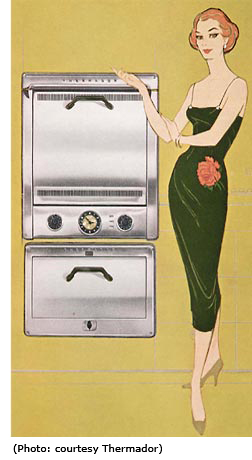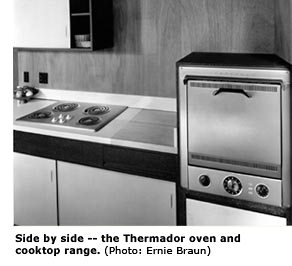Thermador Ovens and Cooktops
 In 1956 the late Catherine Munson and her husband went to dinner at their friends' new Eichler home in Marin County. Their hosts eschewed '50s-era fare like tuna noodle casserole in favor of fresh ingredients. Together, they ate casually, trading anecdotes across the large kitchen while munching appetizers warmed in the brand-new Thermador oven.
In 1956 the late Catherine Munson and her husband went to dinner at their friends' new Eichler home in Marin County. Their hosts eschewed '50s-era fare like tuna noodle casserole in favor of fresh ingredients. Together, they ate casually, trading anecdotes across the large kitchen while munching appetizers warmed in the brand-new Thermador oven.
The oven had a flat, lightweight metallic door with a line of oversized dials on the trim and a straight handle across the top. Set in a cabinet housing at waist height, it shared the countertop alongside a stylish electric cooktop range. This oven was special. It was the WO-16A, the first line of wall-mounted ovens, adaptable for countertops, produced by the Thermador company of Los Angeles. It was the top of the line for the time, rivaling gas models for efficiency and power.
Back then, the WO-16A (and soon thereafter the slightly larger WO-18A) debuted in Eichler homes, reinventing the modern kitchen as part of Eichler's bold new-concept homes. The Thermador oven and its accompanying cooktop range came integrated into the house just as the house was designed to feel integrated into nature. The oven's sleek design matched the home, and the Munsons were impressed.
The large-paned windows, spacious feel, and stark, clean lines of the modern home moved the Munsons to buy one of their own. Before the year was out, Catherine Munson was in the habit of strolling the sidewalks of her new neighborhood, in Eichler's up-and-coming Terra Linda subdivision. "I'd visit the sales office almost every day," she said. "I'd go there to get ideas for my house or just walk the baby. Eventually they suggested I come to work for them one day a week." Munson hired a sitter and went to work as a part-time hostess, welcoming potential buyers to the Eichler sales office. Within a year she was working full time as Eichler's first female salesperson, an uncommon position for a woman in the 1950s.
Munson's career path fell in line with the Eichler model of home integration. What's more, the forward-thinking Eichler hired her because she was simply effective—the same reason he made many of the choices that shaped his unique homes. "Form follows function," Munson said of Thermador's success, "and they functioned very well. "In all my years with Eichler, I never saw anything but Thermador in an Eichler home."
The built-in oven and detached cooktop range have become the norm rather than the exception, while Eichler's integrated living spaces have permeated most new and remodel housing designs. A glance at any architecture publication will indicate one of the hottest trends in home renewal today is knocking down the wall between the kitchen and dining or living room to create a large integrated space. With the help of Thermador, Joe Eichler sparked that trend.
The Thermador company started in 1916 as Thermador Electric Products, producing, in addition to a line of irons and other domestic tools, a cow-milking stool that warmed the farmer's posterior during the cold months. In the early 1930s, the company began manufacturing electric wall and space heaters, introducing zone heating. By the mid '30s, it began producing electronic components such as transformers and voltage regulation equipment for radios.

During World War II Thermador manufactured almost exclusively for the military. It developed sealed transformers that could keep radios working in the humidity of the South Pacific and the aridity of the African front. As the war drew to a close, the company began seeking civil applications. With its capacity to produce stamped-steel and electric heating elements as well as sophisticated electronics, and noticing the boom in suburban housing, Thermador moved into kitchen appliances.
The company's first 'Bilt-in' oven, as they were known in the advertising campaign, was the model WO-16, which measured 22 inches across and had about two cubic feet of capacity. They came in stainless steel, with a line of gauges that included a clock, a thermostat, and selector to determine bake, broil, or time bake.
The straight, streamlined design, metallic finish, and round, glassed-in gauges were all design elements lifted from military aircraft of World War II. As America entered the space age, design trends followed suit, and Thermador embodied those trends. Its control panel reminded one of the cockpit of a plane; its aerodynamic design mirrored that of new airliners and automobiles.




